
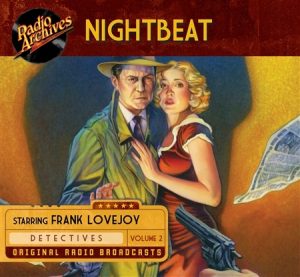 Night Beat (1950-52) aired “The Hunter Becomes the Hunted” on September 11, 1950 as its 32nd episode out of approximately 118 (depending on how one counts). Some 80 episodes are estimated to remain in circulation. This radio noir “detective” show featured film–-and later TV–-star Frank Lovejoy (1912-1962) as Randy Stone, the night beat reporter for the fictional Chicago Star newspaper.
Night Beat (1950-52) aired “The Hunter Becomes the Hunted” on September 11, 1950 as its 32nd episode out of approximately 118 (depending on how one counts). Some 80 episodes are estimated to remain in circulation. This radio noir “detective” show featured film–-and later TV–-star Frank Lovejoy (1912-1962) as Randy Stone, the night beat reporter for the fictional Chicago Star newspaper.
This is the 11th episode of Night Beat we have showcased, the first being “The Devil’s Bible” from July of 2013. We presented our last episode in December of 2024, a few months shy of a year ago. While well received, Night Beat ran for a modest two years before being cancelled, but not from any fault of its own. It had two factors going against it, both with origins at NBC. The time for a new radio show, and for a network to pour money into it, wasn’t the best. The early 1950s was becoming a growth spurt for the relatively new medium of television, and advertisers realizing its much larger potential audience were diverting their ad dollars away from radio and into this promising new market. Secondly, and for whatever reason, NBC around this time had a reputation for not supporting many of its shows with in-house advertising around the country, or allowing them the benefit of stable time slots so audiences could plan on listening to their favorite shows at a regular time. Both of these factors had a role in Night Beat‘s short life span. NBC would move it from one day of the week to another and at a different nightly time slot, without notice or fanfare, making it difficult for its audience to follow. Thus, while the show was a success, it was in spite of NBC, not because of anything its parent network did to support it.
As noted above, Frank Lovejoy portrayed Randy Stone, the night beat reporter for the fictional newspaper, the Chicago Star. He wasn’t the show’s first choice, however. Noted film actor Edmond O’Brien played Stone in an audition episode, but the censorship watchdogs that had for a long time been active in radio (so one theory goes, true or not) felt O’Brien’s hardcore, gritty characterization of Stone to be too stark for younger listeners, so decreed that Night Beat would have to air in a later time slot (after 9:30 PM) if it was to be given a green light. Rather than moving their new show in the making to a late night venue (with fewer listeners and thus fewer potential ad dollars spent), they would soften the Stone character. Enter Frank Lovejoy, with a voice historians would later place in the top ten of the most distinctive voices in radio. Lovejoy also brought his own sense of down to earth humanity and heartfelt compassion to the role (which he did to all of his radio roles, some 3,000 productions during his radio career), and Night Beat had its winning formula.
Lovejoy was a well known and respected film actor in the 1940s and 50s, having supporting or major roles in more than two dozen films, a scant few of many worth mentioning being 1949’s In a Lonely Place (starring Humphrey Bogart), and the title role in the classic 1951 noir crime thriller I Was a Communist for the FBI. Lovejoy featured prominently in several world War II and/or Korean War films, the most high profile probably his co-starring role with James Stewart in 1954’s Strategic Air Command. Of interest to SF genre fans is Lovejoy’s role as Lt. Tom Brennan opposite Vincent Price in the 1953 3D horror flick House of Wax (the first color 3D film to be released by a major American studio, and the first in a regular theater setting to offer stereophonic sound).
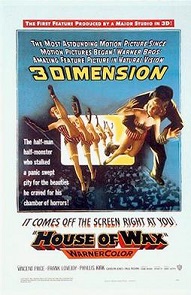
“The Hunter Becomes the Hunted” begins with both feet hitting the ground running and never slows down. A convicted murderer escapes from the authorities transporting him to prison. He immediately seeks out and takes Randy Stone hostage because it is his belief that it was Randy’s negative press coverage of his trial and belief in his guilt that influenced public opinion, and the jury, against him. At gun point, the murderer forces Randy to help prove his innocence before the cops find him and send him to prison for good, but is also bitter that his fate was in part sealed because of Randy’s damaging reporting. He realizes it won’t be long before the cops find and kill him if necessary, so he swears to Randy that before the cops can kill him he will shoot and kill Randy first. Caught between a rock and a hard place, Randy faces the most harrowing experience of his reporting life as the tables are turned in a most unexpected way so that “The Hunter Becomes the Hunted.”
(The linked CD at top includes this episode and 19 others, all remastered and restored.)
Play Time: 28:55
{This episode of Night Beat aired on a Monday evening in early September of 1950. The neighborhood gang was just getting used to the schedule that a new school year forced upon them, and so was more than ready to hit the nearby newsstand the next afternoon after school. Detective Tales (1935-53) was a highly popular detective magazine, running for 18 years and over 200 issues, most monthly. Most of its issues gave readers 12 stories for a dime until mid-1944 when the price rose to 15 cents. It jumped again in February of 1948 to 25 cents but included 3 more stories per issue. It was a monthly in 1950 though it did miss its 12th, December issue. 15 Mystery Stories (1932-50) began under the title of Dime Mystery Magazine (after its original title of Dime Mystery Book Magazine lasted but 10 issues). It was a monthly until 1941 when it dropped to a bi-monthly schedule, and only became 15 Mystery Stories for its final 5 bi-monthly issues in 1950. The issue shown below was its last. New Detective Magazine (1941-53) ran more or less the usual assortment of crime fiction, but with an emphasis on police detectives. It was a bi-monthly for its entire publishing life even though it would go through two format and title changes, the first in late 1953 when it became Fifteen Detective Stories and began running 15 stories an issue, and then lamentably foregoing the detective format altogether to become a men’s magazine in September of 1955 called True Adventures. New Detective Magazine was a bi-monthly in 1950.}
[Left: Detective Tales, 9/50 – Center: 15 Mystery Stories, 10/50 – Right: New Detective Stories, 9/50]
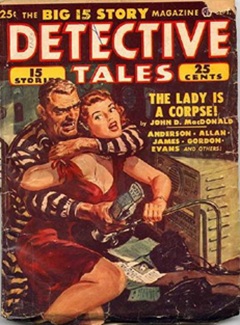
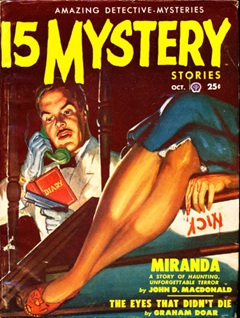
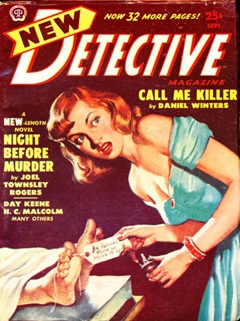
To view the entire list of weekly Old Time Radio episodes at Tangent Online, click here.